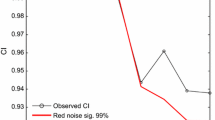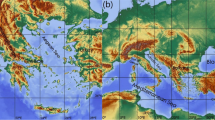Abstract
The use of weather types for the definition of seasons is examined. Specifically, an objective definition of seasons is attempted for the southern Balkans based on the intra-annual variations of the frequencies of the objectively defined weather types. The methodology includes a combined application of Principal Component Analysis and k-means Cluster Analysis on daily grid point meteorological data obtained from the ERA5 database, for the 40-year period 1979–2018. The methodology is used at first for the classification of weather types and then for the definition of seasons based on the intra-annual variations of the weather types’ frequency. The application of the methodology results in nine weather types and four seasons. The characteristics of the defined weather types are connected to the prevalence of specific atmospheric circulation patterns, the windward or leeward character of the various sub-regions, and the thermal characteristics of the earth’s surface. The four seasons generally correspond to the conventional ones, but they present differences regarding their onset and cessation dates and their duration.

















Similar content being viewed by others
References
Abercromby R (1883) On certain types of British weather. Q J Roy Meteor Soc 9:1–25
Anagnostopoulou C, Tolika K, Maheras P (2009) Classification of circulation types: a new flexible automated approach applicable to NCEP and GCM datasets. Theor Appl Climatol 96(1–2):3–15
Anagnostopoulou C, Zanis P, Katragkou E, Tegoulias I, Tolika K (2014) Recent past and future patterns of the etesian winds based on regional scale climate model simulations. Clim Dyn 42(7–8):1819–1836
Argiriou A, Kassomenos P, Lykoudis S (2004) On the methods for the delimitation of seasons. Water Air Soil Poll: Focus 4:65–74
Bárdossy A, Stehlík J, Caspary H-J (2002) Automated objective classification of daily circulation patterns for precipitation and temperature downscaling based on optimized fuzzy rules. Clim Res 23(1):11–22
Barry RG, Perry AH (1973) Synoptic climatology: methods and applications. Methuen, London
Bartzokas A, Metaxas DA (1995) Factor analysis of some climatological elements in Athens, 1931-1992: covariability and climatic change. Theor Appl Climatol 52(3–4):195–205
Blasing TJ (1975) A comparison of map-pattern correlation and principal component eigenvector methods for analyzing climatic anomaly patterns. Fourth Conference in Probability and Statistics in Atmospheric Sciences, American Meteorological Society, pp 118–25
Bradka J (1966) Natural seasons in the northern hemisphere. Geofys Sb 14:597–648
Christensen WI Jr, Bryson RA (1966) An investigation of the potential of component analysis for weather classification. Mon Weather Rev 94(12):697–709
Comrie AC, Yarnal B (1992) Relationships between synoptic-scale atmospheric circulation and ozone concentrations in Metropolitan Pittsburgh, Pennsylvania. Atmos Environ, Part B, Urban Atmos 26(3):301–312
Copernicus Climate Change Service (C3S) (2017): ERA5: fifth generation of ECMWF atmospheric reanalyses of the global climate. Copernicus Climate Change Service Climate Data Store (CDS), 21/11/2019. https://cds.climate.copernicus.eu/cdsapp#!/home
Dafis S, Lolis CJ, Houssos EE, Bartzokas A (2016) The atmospheric circulation characteristics favoring snowfall in an area with complex relief in northwestern Greece. Int J Climatol 36(10):3561–3577
Dafka S, Toreti A, Zanis P, Xoplaki E, Luterbacher J (2019) Twenty-first-century changes in the eastern Mediterranean Etesians and associated midlatitude atmospheric circulation. J Geophys Res Atmos 124(23):12741–12754
Davis RE, Kalkstein LS (1990) Development of an automated spatial synoptic climatological classification. Int J Climatol 10(8):769–794
Hoard DE, Lee JT (1986) Synoptic classification of a ten-year record of 500 mb weather maps for the western United States. Meteorog Atmos Phys 35(1–2):96–102
Houssos EE, Bartzokas A (2006) Extreme precipitation events in NW Greece. Adv Geosci 7:91–96
Houssos EE, Lolis CJ, Bartzokas A (2008) Atmospheric circulation patterns associated with extreme precipitation amounts in Greece. Adv Geosci 17:5–11
Houssos EE, Lolis CJ, Bartzokas A (2009) The main characteristics of atmospheric circulation associated with fog in Greece. Nat Hazards Earth Syst Sci 9:1857–1869
Huth R, Beck C, Philipp A, Demuzere M, Ustrnul Z, Cahynová M, Kyselý J, Tveito OE (2008) Classifications of atmospheric circulation patterns: recent advances and applications. Ann N Y Acad Sci 1146:105–152
Huth R, Beck C, Kučerová M (2016) Synoptic-climatological evaluation of the classifications of atmospheric circulation patterns over Europe. Int J Climatol 36(7):2710–2726
Ioannidis E, Lolis CJ, Papadimas CD, Hatzianastassiou N, Bartzokas A (2018) On the intra-annual variation of cloudiness over the Mediterranean region. Atmos Res 208:246–256
Jiang N (2011) A new objective procedure for classifying New Zealand synoptic weather types during 1958-2008. Int J Climatol 31(6):863–879
Jolliffe IT (1986) Principal component analysis. Springer, New York
Kalimeris A, Kolios S (2019) TRMM-based rainfall variability over the Central Mediterranean and its relationships with atmospheric and oceanic climatic modes. Atmos Res 230:104649
Kalkstein LS, Nichols MC, Barthel CD, Greene JS (1996) A new spatial synoptic classification: application to air mass analysis. Int J Climatol 16:983–1004
Kutiel H, Maheras P, Türkeş M, Paz S (2002) North Sea - Caspian pattern (NCP) - an upper level atmospheric teleconnection affecting the eastern Mediterranean - implications on the regional climate. Theor Appl Climatol 72(3–4):173–192
Labosier CF, Frauenfeld OW, Quiring SM, Lafon CW (2015) Weather type classification of wildfire ignitions in the Central Gulf Coast, United States. Int J Climatol 35(9):2620–2634
Littmann T (2000) An empirical classification of weather types in the Mediterranean Basin and their interrelation with rainfall. Theor Appl Climatol 66(3–4):161–171
Lolis CJ (2007) Climatic features of atmospheric stability in the Mediterranean region (1948-2006): spatial modes, inter-monthly and inter-annual variability. Meteorol Appl 14:361–379
Lolis CJ (2012) High-resolution precipitation over the southern Balkans. Clim Res 55:167–179
Lolis CJ (2017) A climatology of convective available potential energy in the Mediterranean region. Clim Res 74:15–30
Lolis CJ, Türkeş M (2016) Atmospheric circulation characteristics favouring extreme precipitation in Turkey. Clim Res 71(2):139–153
Lolis CJ, Metaxas DA, Bartzokas A (2008) On the intra-annual variability of atmospheric circulation in the Mediterranean region. Int J Climatol 28:1339–1355
Lolis CJ, Bartzokas A, Lagouvardos K, Metaxas DA (2012) Intra-annual variation of atmospheric static stability in the Mediterranean region: a 60-year climatology. Theor Appl Climatol 110:245–261
Maheras P (1984) Weather-type classification by factor analysis in the Thessaloniki area. J Climatol 4(4):437–443
Maheras P (1988) The synoptic weather types and objective delimitation of the winter period in Greece. Weather 43(2):40–45
Maheras P (1989) Delimitation of the summer-dry period in Greece according to the frequency of weather-types. Theor Appl Climatol 39(3):171–176
Maheras P, Patrikas I, Karacostas T, Anagnostopoulou C (2000) Automatic classification of circulation types in Greece: methodology, description, frequency, variability and trend analysis. Theor Appl Climatol 67(3–4):205–223
Maheras P, Tolika K, Anagnostopoulou C, Kolyva-Machera F (2017) Evolution of the methods of analysis of weather and circulation types in Greece during the last 60 years. BSGLg 68(1):109–118
Maheras P, Tolika K, Tegoulias I, Anagnostopoulou C, Szpirosz K, Károssy C, Makra L (2019) Comparison of an automated classification system with an empirical classification of circulation patterns over the Pannonian basin, Central Europe. Meteorog Atmos Phys 131(4):739–751
McGregor GR, Bamzelis D (1995) Synoptic typing and its application to the investigation of weather air pollution relationships, Birmingham, United Kingdom. Theor Appl Climatol 51:223–236
Mellado-Cano J, Barriopedro D, García-Herrera R, Trigo RM, Hernández A (2019) Examining the North Atlantic oscillation, East Atlantic pattern, and jet variability since 1685. J Clim 32(19):6285–6298
Michailidou C, Maheras P, Arseni-Papadimititriou A, Kolyva-Machera F, Anagnostopoulou C (2009) A study of weather types at Athens and Thessaloniki and their relationship to circulation types for the cold-wet period, part I: two-step cluster analysis. Theor App Climatol 97(1–2):163–177
Mohammed AJ, Alarcón M, Pino D (2018) Extreme temperature events on the Iberian Peninsula: statistical trajectory analysis and synoptic patterns. Int J Climatol 38(14):5305–5322
Ng A, Jordan M, Weiss Y (2002) On spectral clustering: analysis and an algorithm. In: Dietterich T, Becker S, Ghahramani Z (eds) Adv Neural Inf Proc Syst, vol 14. MIT Press, Cambridge, pp 849–856
Overland JE, Preisendorfer RW (1982) A significance test for principal components applied to a cyclone climatology. Mon Weather Rev 110:1–4
Piotrowicz K, Ciaranek D (2020) A selection of weather type classification systems and examples of their application. Theor Appl Climatol (in press)
Poupkou A, Zanis P, Nastos P, Papanastasiou D, Melas D, Tourpali K, Zerefos C (2011) Present climate trend analysis of the etesian winds in the Aegean Sea. Theor Appl Climatol 106(3–4):459–472
Richman MB (1986) Rotation of principal components. J Climatol 6:293–335
Serbis E, Lolis CJ, Kassomenos PA (2015) Atmospheric circulation characteristics associated with daytime extreme static instability over Athens, Greece. Clim Res 64:111–122
Sharma S (1995) Applied multivariate techniques. Wiley, New York
Sugar AC, James MG (2003) Finding the number of clusters in a dataset: an information—theoretic approach. J Am Stat Assoc 98:750–763
Tatli H, Menteş ŞS (2019) Detrended cross-correlation patterns between North Atlantic oscillation and precipitation. Theor App Climatol 138(1–2):387–397
Türkeş M, Tatli H (2011) Use of the spectral clustering to determine coherent precipitation regions in Turkey for the period 1929-2007. Int J Climatol 31(14):2055–2067
Tyrlis E, Lelieveld J (2013) Climatology and dynamics of the summer etesian winds over the eastern Mediterranean. J Atmos Sci 70(11):3374–3396
Zagouras A, Argiriou AA, Flocas HA, Economou G, Fotopoulos S (2012) An advanced method for classifying atmospheric circulation types based on prototypes connectivity graph. Atmos Res 118:180–192
Acknowledgments
Acknowledgement is made for the use of ECMWF computing and archive facilities in this research, generated using Copernicus Climate Change Service information.
Availability of data and material
The data used in this study will be available on request.
Author information
Authors and Affiliations
Corresponding author
Ethics declarations
Conflict of interest
The authors declare that they have no conflict of interest.
Code availability
Not applicable.
Additional information
Publisher’s note
Springer Nature remains neutral with regard to jurisdictional claims in published maps and institutional affiliations.
Rights and permissions
About this article
Cite this article
Lolis, C.J., Kotsias, G. The use of weather types in the definition of seasons: the case of southern Balkans. Theor Appl Climatol 142, 1199–1219 (2020). https://doi.org/10.1007/s00704-020-03369-z
Received:
Accepted:
Published:
Issue Date:
DOI: https://doi.org/10.1007/s00704-020-03369-z




